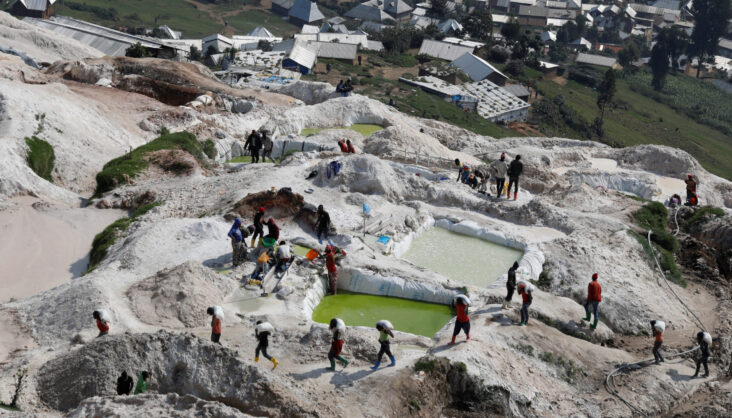[ad_1]
The northeastern part of the country contains gold, coal and iron-ore deposits, and coltan – a term derived from the word ‘columbite-tantalite’ that belongs to a group of geochemical products internationally known as tantalum.
The demand is increasing as 5G technology grows, owing to the requirement for low-voltage capacitors in the fast-growing telecommunications sector. Global coltan production was estimated at about 2.3 kilotons in 2020 and is expected to grow at a compound annual rate of about six per cent between 2021 and 2026. In 2021, the DRC’s coltan production amounted to an estimated 700 metric tons, thus it was the world’s largest coltan producer by far.
In spite of the significance of coltan to global technological development, smuggling of this essential mineral in the DRC has remained a lingering challenge to the state according to a new study. Successive administrations in the country, both the central and provincial governments, have not shown sufficient appetite for undertaking the policy changes and public commitment to address the menace of coltan smuggling. Thus, coltan smuggling is enabled by a gamut of factors including porous borders, the protracted war economy, and cross-border price differential.
Porous borders
The vast expanse of ungoverned spaces of the DRC’s borders, stretching from Burundi and Rwanda to Uganda, provides ideal geography for illicit trading of strategic minerals. Even where state security agents from these countries are deployed to secure the frontiers, the unscrupulous personnel among them often look the other way when coltan smuggling occurs. Corrupt Congolese border protection and customs officers also collude with the smugglers.
Coltan trafficking is also diverted to Uganda via Bunagana, in Rutshuru territory, North Kivu. Likewise, a portion of the trade directed to Bukavu is diverted to Burundi via Uvira, in Uvira territory, South Kivu, using the Gatumba and Kavinvira border crossings. In one incident, a truck crossing the border from the DRC to Rwanda was found to be carrying 24 sacks of smuggled coltan. Evidence from a UN report shows that 10 and 20 kilogram bags of coltan from the eastern DRC are sold by unregistered traders to Rwandan buyers through smuggling routes.
Protracted war economy
In the Great Lakes Region, the DRC stands at the centre of the instability which is often described as a transnational war economy. It is a situation in which wealth-seeking government officials collude with rebel leaders and international businesses to perpetrate illicit trading of minerals. These actors have a common interest in expanding and preserving the war economy.
Most of these ungoverned spaces are naturally endowed with strategic minerals. Warlords created by the Congolese civil wars and remnants of Rwandan genocide rebels have unfettered access to coltan deposits.
The article continues below

Free download
Get your free PDF: Top 200 banks 2019
The race to transform
Complete the form and download, for free, the highlights from The Africa Report’s Exclusive Ranking of Africa’s top 200 banks from last year. Get your free PDF by completing the following form
They continue to mine the mineral and trade it in the legitimate commodity market through corrupt middlemen. Struggle for control over coltan mines is central to the conflict in eastern Congo, which has claimed more than four million lives over the past decade. The state security actors and the armed militias all have stakes in the lucrative coltan trade. State agents and warlords tax the miners for access to the mines, making control of the sites violently competitive.
Cross-border price differential
Coltan smuggling from the DRC flourishes because of variations in prices set in mining areas and those found in the black markets of northern Katanga, Goma, South Kivu in DRC and Gisenyi in Rwanda. In 2014 one kilogram of coltan cost $37.50 in Bukavu, $44 in Uvira and $34 in Kalemie. Each of these prices exceeded what was set in the mines, which ranged from $28.80 to $40 in Kisengo and Mai-Baridi. In 2015, a kilogram of coltan sold for $40 – $50.
Price fluctuations within and across borders have played a major role in coltan mining and trading. In 2016, a kilogram was traded at a peak price of $100 in the DRC. Subsequently, in 2017, the kilogram price of coltan plummeted in Congo to $20 – $24. Whereas, many mineral traders from Kisengo region in the country reportedly crossed the border often and sold the ore in Kigali, for more than $50 per kilo. In 2018 and 2019, the average price of Coltan prices was $23.85/kg and $36/kg respectively.
Depending on the percentage of tantalum concentrate in the coltan, the mineral traded in the range of $35 and $52.50 per kilogram in 2021 in Congo. Conversely, in neighbouring Rwanda, coltan traded for $52 – $65 per lb (0.5kg) in the same year. Thus, price variations contribute to flourishing black markets, feed broader patterns relating to cross-border smuggling and sustain shadowy commercial networks in the coltan supply chain.
Pathways to solution
The solution to coltan smuggling cannot come from the DRC alone. The approach must be multi-pronged involving the national government, multilateral partnerships and the business community.
The central government must drive initiatives to ensure the establishment of coltan refining plant(s) in North and South Kivu in line with broader national and provincial development plans with a view to reducing the propensity for illicit cross-border trading of coltan.
This can be done through joint ventures with foreign and local investors subject to extant legislative frameworks to rid such partnerships of potential corruption. The state should address border corruption among security officials by simplifying and harmonising procedures, encouraging the use of new technologies, and focusing on organisational and institutional development by improving the welfare of border personnel.
The upstream and downstream businesses engaging in the trading of coltan must enhance traceability by tracking specific information on the mine of origin, methods of extraction, quantity purchased, date of purchase, trading locations, intermediaries engaged to transport the minerals, and the actual transportation routes.
[ad_2]
Source link

